Cloud Computing
VerifiedAdded on 2023/01/16
|8
|1783
|77
AI Summary
This report discusses the concept of cloud computing, its architectural framework, principles, and challenges in decision making. It explores the software-defined multi-cloud computing and its future directions.
Contribute Materials
Your contribution can guide someone’s learning journey. Share your
documents today.
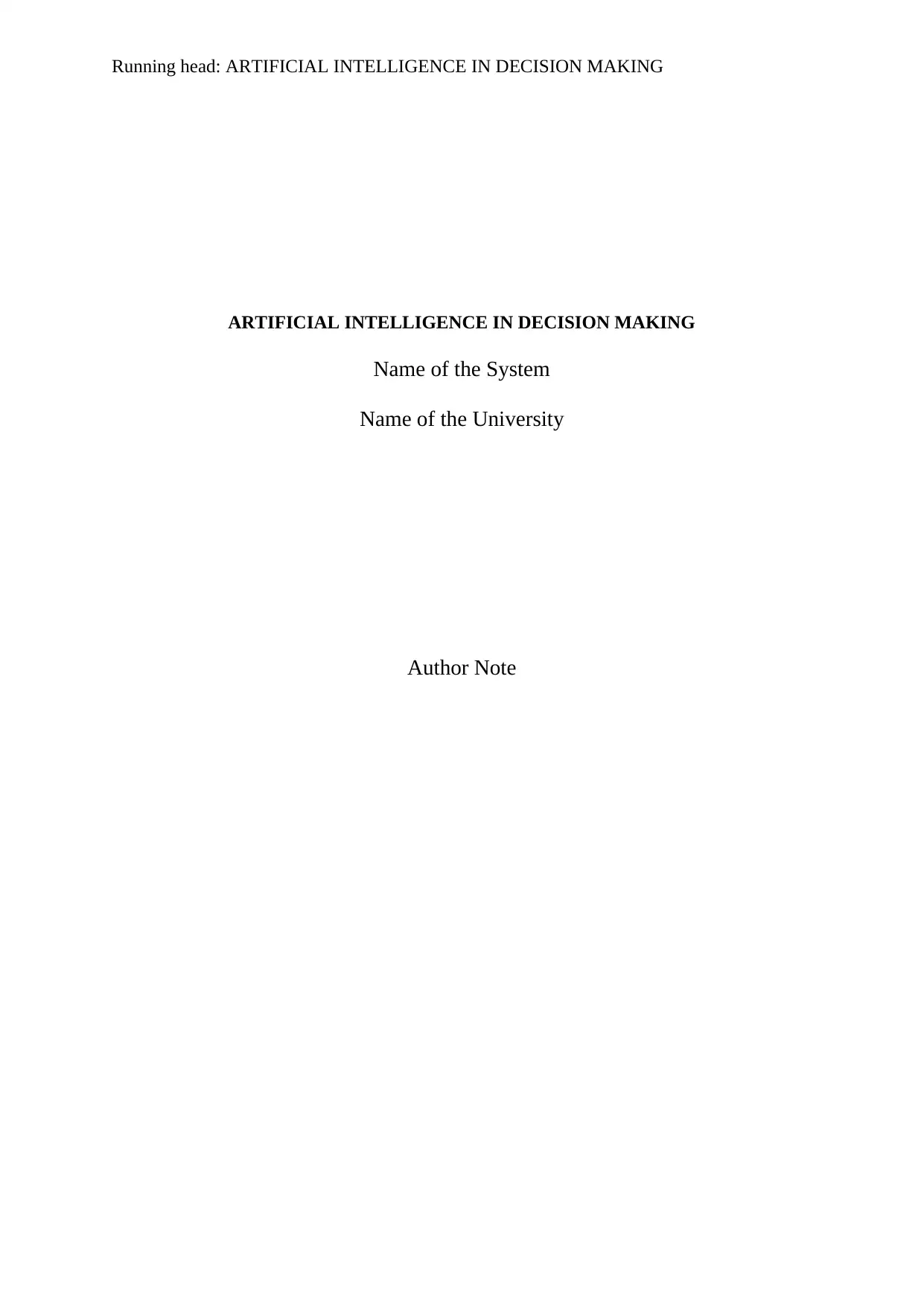
Running head: ARTIFICIAL INTELLIGENCE IN DECISION MAKING
ARTIFICIAL INTELLIGENCE IN DECISION MAKING
Name of the System
Name of the University
Author Note
ARTIFICIAL INTELLIGENCE IN DECISION MAKING
Name of the System
Name of the University
Author Note
Secure Best Marks with AI Grader
Need help grading? Try our AI Grader for instant feedback on your assignments.
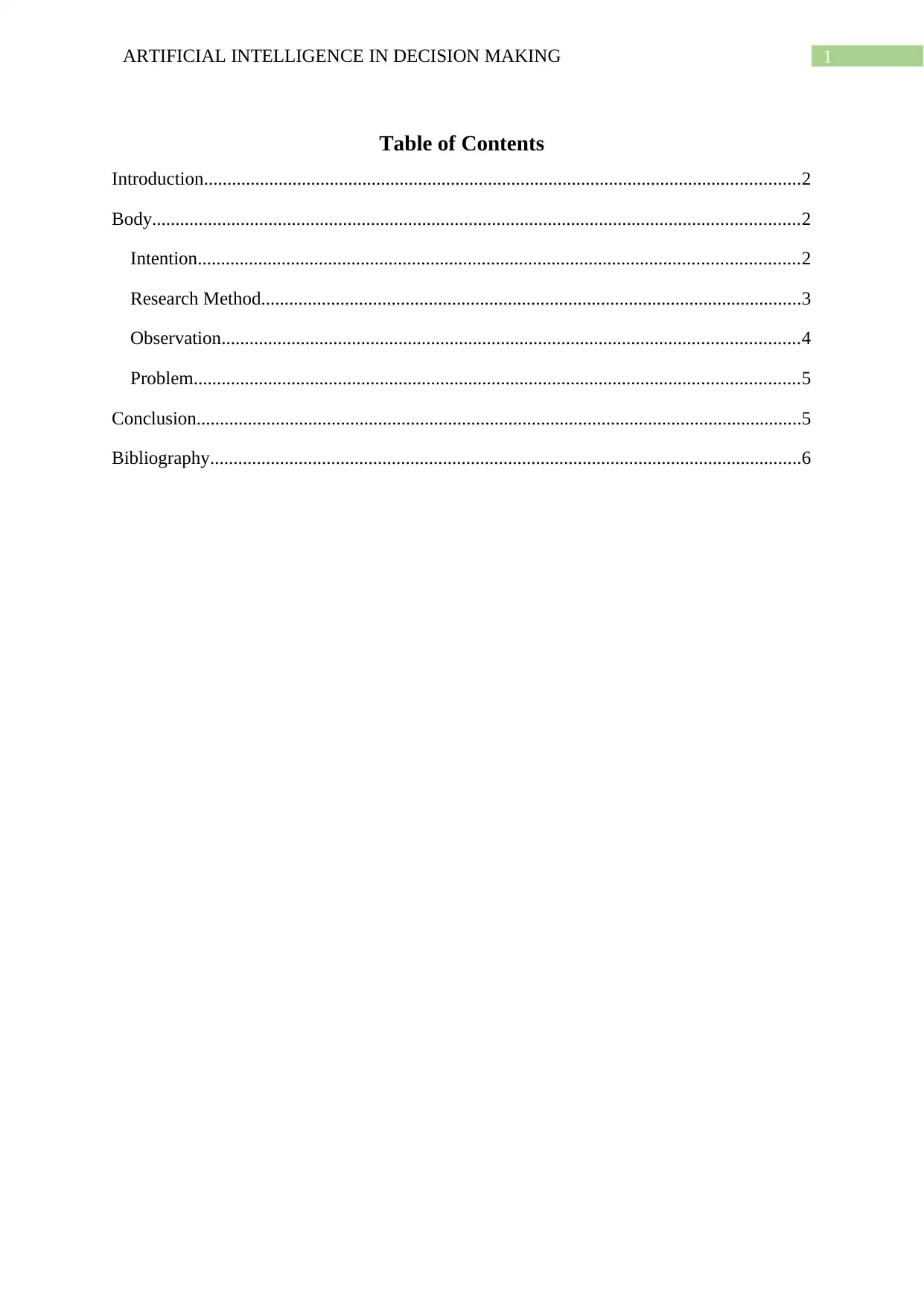
1ARTIFICIAL INTELLIGENCE IN DECISION MAKING
Table of Contents
Introduction................................................................................................................................2
Body...........................................................................................................................................2
Intention.................................................................................................................................2
Research Method....................................................................................................................3
Observation............................................................................................................................4
Problem..................................................................................................................................5
Conclusion..................................................................................................................................5
Bibliography...............................................................................................................................6
Table of Contents
Introduction................................................................................................................................2
Body...........................................................................................................................................2
Intention.................................................................................................................................2
Research Method....................................................................................................................3
Observation............................................................................................................................4
Problem..................................................................................................................................5
Conclusion..................................................................................................................................5
Bibliography...............................................................................................................................6
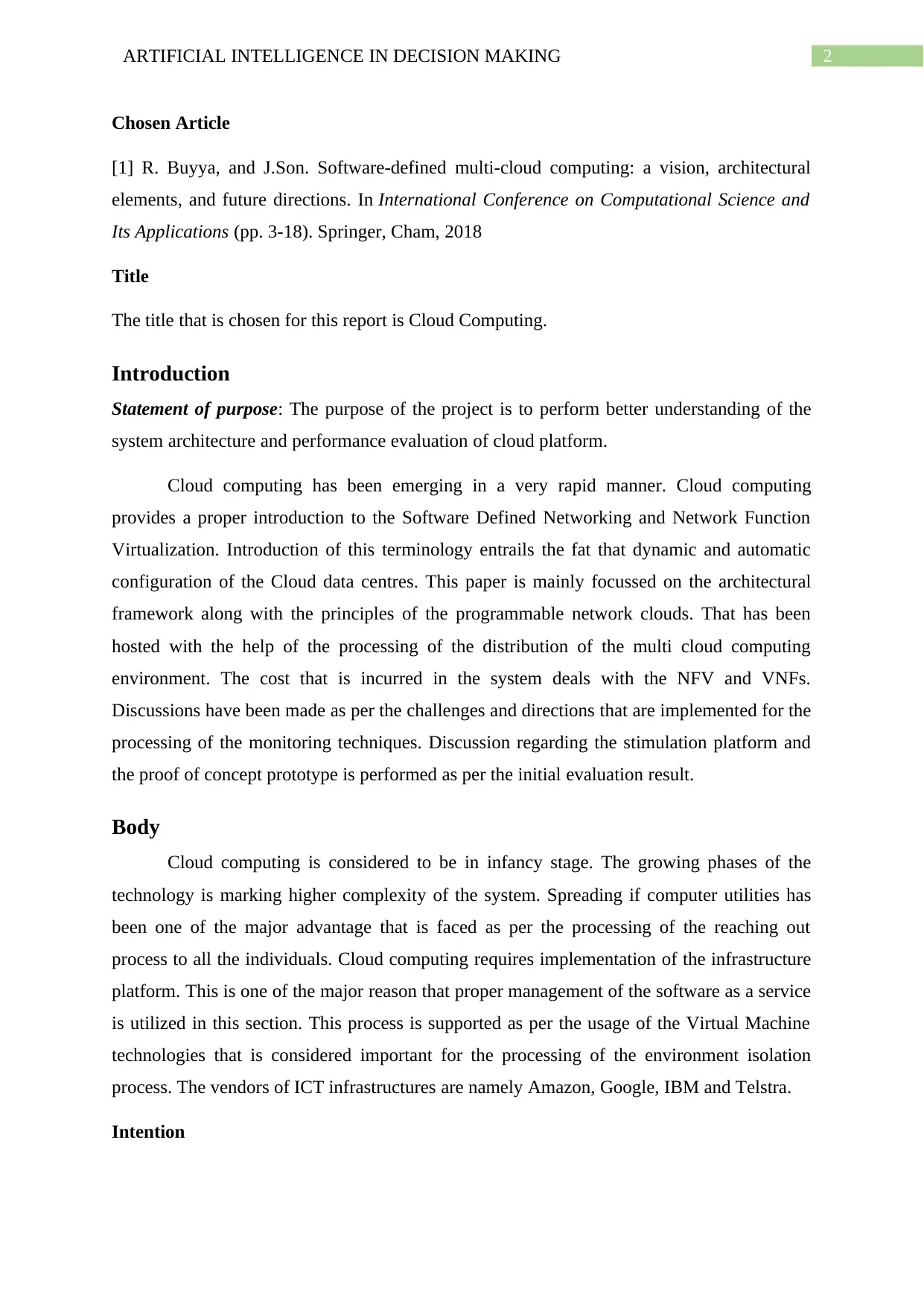
2ARTIFICIAL INTELLIGENCE IN DECISION MAKING
Chosen Article
[1] R. Buyya, and J.Son. Software-defined multi-cloud computing: a vision, architectural
elements, and future directions. In International Conference on Computational Science and
Its Applications (pp. 3-18). Springer, Cham, 2018
Title
The title that is chosen for this report is Cloud Computing.
Introduction
Statement of purpose: The purpose of the project is to perform better understanding of the
system architecture and performance evaluation of cloud platform.
Cloud computing has been emerging in a very rapid manner. Cloud computing
provides a proper introduction to the Software Defined Networking and Network Function
Virtualization. Introduction of this terminology entrails the fat that dynamic and automatic
configuration of the Cloud data centres. This paper is mainly focussed on the architectural
framework along with the principles of the programmable network clouds. That has been
hosted with the help of the processing of the distribution of the multi cloud computing
environment. The cost that is incurred in the system deals with the NFV and VNFs.
Discussions have been made as per the challenges and directions that are implemented for the
processing of the monitoring techniques. Discussion regarding the stimulation platform and
the proof of concept prototype is performed as per the initial evaluation result.
Body
Cloud computing is considered to be in infancy stage. The growing phases of the
technology is marking higher complexity of the system. Spreading if computer utilities has
been one of the major advantage that is faced as per the processing of the reaching out
process to all the individuals. Cloud computing requires implementation of the infrastructure
platform. This is one of the major reason that proper management of the software as a service
is utilized in this section. This process is supported as per the usage of the Virtual Machine
technologies that is considered important for the processing of the environment isolation
process. The vendors of ICT infrastructures are namely Amazon, Google, IBM and Telstra.
Intention
Chosen Article
[1] R. Buyya, and J.Son. Software-defined multi-cloud computing: a vision, architectural
elements, and future directions. In International Conference on Computational Science and
Its Applications (pp. 3-18). Springer, Cham, 2018
Title
The title that is chosen for this report is Cloud Computing.
Introduction
Statement of purpose: The purpose of the project is to perform better understanding of the
system architecture and performance evaluation of cloud platform.
Cloud computing has been emerging in a very rapid manner. Cloud computing
provides a proper introduction to the Software Defined Networking and Network Function
Virtualization. Introduction of this terminology entrails the fat that dynamic and automatic
configuration of the Cloud data centres. This paper is mainly focussed on the architectural
framework along with the principles of the programmable network clouds. That has been
hosted with the help of the processing of the distribution of the multi cloud computing
environment. The cost that is incurred in the system deals with the NFV and VNFs.
Discussions have been made as per the challenges and directions that are implemented for the
processing of the monitoring techniques. Discussion regarding the stimulation platform and
the proof of concept prototype is performed as per the initial evaluation result.
Body
Cloud computing is considered to be in infancy stage. The growing phases of the
technology is marking higher complexity of the system. Spreading if computer utilities has
been one of the major advantage that is faced as per the processing of the reaching out
process to all the individuals. Cloud computing requires implementation of the infrastructure
platform. This is one of the major reason that proper management of the software as a service
is utilized in this section. This process is supported as per the usage of the Virtual Machine
technologies that is considered important for the processing of the environment isolation
process. The vendors of ICT infrastructures are namely Amazon, Google, IBM and Telstra.
Intention
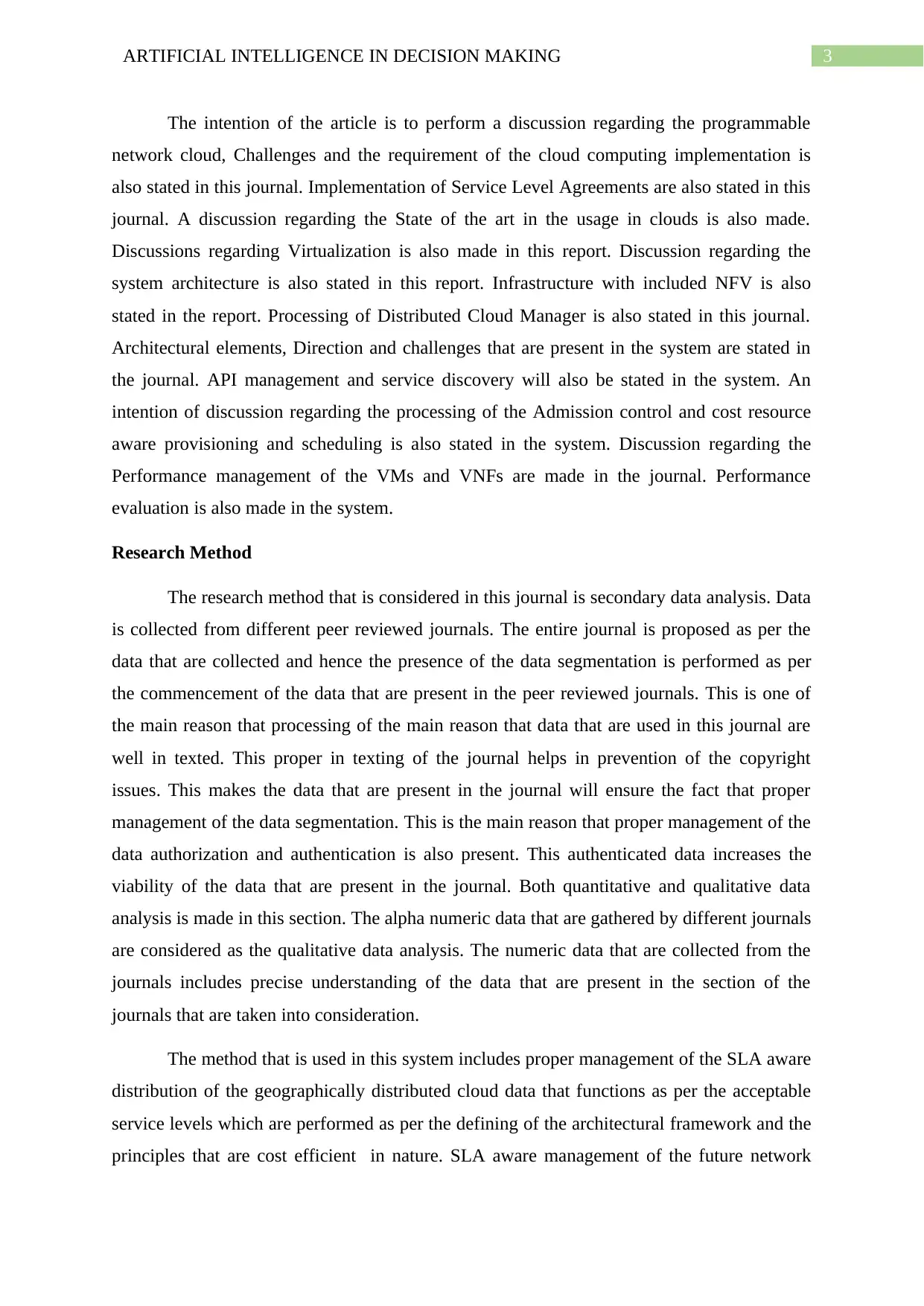
3ARTIFICIAL INTELLIGENCE IN DECISION MAKING
The intention of the article is to perform a discussion regarding the programmable
network cloud, Challenges and the requirement of the cloud computing implementation is
also stated in this journal. Implementation of Service Level Agreements are also stated in this
journal. A discussion regarding the State of the art in the usage in clouds is also made.
Discussions regarding Virtualization is also made in this report. Discussion regarding the
system architecture is also stated in this report. Infrastructure with included NFV is also
stated in the report. Processing of Distributed Cloud Manager is also stated in this journal.
Architectural elements, Direction and challenges that are present in the system are stated in
the journal. API management and service discovery will also be stated in the system. An
intention of discussion regarding the processing of the Admission control and cost resource
aware provisioning and scheduling is also stated in the system. Discussion regarding the
Performance management of the VMs and VNFs are made in the journal. Performance
evaluation is also made in the system.
Research Method
The research method that is considered in this journal is secondary data analysis. Data
is collected from different peer reviewed journals. The entire journal is proposed as per the
data that are collected and hence the presence of the data segmentation is performed as per
the commencement of the data that are present in the peer reviewed journals. This is one of
the main reason that processing of the main reason that data that are used in this journal are
well in texted. This proper in texting of the journal helps in prevention of the copyright
issues. This makes the data that are present in the journal will ensure the fact that proper
management of the data segmentation. This is the main reason that proper management of the
data authorization and authentication is also present. This authenticated data increases the
viability of the data that are present in the journal. Both quantitative and qualitative data
analysis is made in this section. The alpha numeric data that are gathered by different journals
are considered as the qualitative data analysis. The numeric data that are collected from the
journals includes precise understanding of the data that are present in the section of the
journals that are taken into consideration.
The method that is used in this system includes proper management of the SLA aware
distribution of the geographically distributed cloud data that functions as per the acceptable
service levels which are performed as per the defining of the architectural framework and the
principles that are cost efficient in nature. SLA aware management of the future network
The intention of the article is to perform a discussion regarding the programmable
network cloud, Challenges and the requirement of the cloud computing implementation is
also stated in this journal. Implementation of Service Level Agreements are also stated in this
journal. A discussion regarding the State of the art in the usage in clouds is also made.
Discussions regarding Virtualization is also made in this report. Discussion regarding the
system architecture is also stated in this report. Infrastructure with included NFV is also
stated in the report. Processing of Distributed Cloud Manager is also stated in this journal.
Architectural elements, Direction and challenges that are present in the system are stated in
the journal. API management and service discovery will also be stated in the system. An
intention of discussion regarding the processing of the Admission control and cost resource
aware provisioning and scheduling is also stated in the system. Discussion regarding the
Performance management of the VMs and VNFs are made in the journal. Performance
evaluation is also made in the system.
Research Method
The research method that is considered in this journal is secondary data analysis. Data
is collected from different peer reviewed journals. The entire journal is proposed as per the
data that are collected and hence the presence of the data segmentation is performed as per
the commencement of the data that are present in the peer reviewed journals. This is one of
the main reason that processing of the main reason that data that are used in this journal are
well in texted. This proper in texting of the journal helps in prevention of the copyright
issues. This makes the data that are present in the journal will ensure the fact that proper
management of the data segmentation. This is the main reason that proper management of the
data authorization and authentication is also present. This authenticated data increases the
viability of the data that are present in the journal. Both quantitative and qualitative data
analysis is made in this section. The alpha numeric data that are gathered by different journals
are considered as the qualitative data analysis. The numeric data that are collected from the
journals includes precise understanding of the data that are present in the section of the
journals that are taken into consideration.
The method that is used in this system includes proper management of the SLA aware
distribution of the geographically distributed cloud data that functions as per the acceptable
service levels which are performed as per the defining of the architectural framework and the
principles that are cost efficient in nature. SLA aware management of the future network
Secure Best Marks with AI Grader
Need help grading? Try our AI Grader for instant feedback on your assignments.
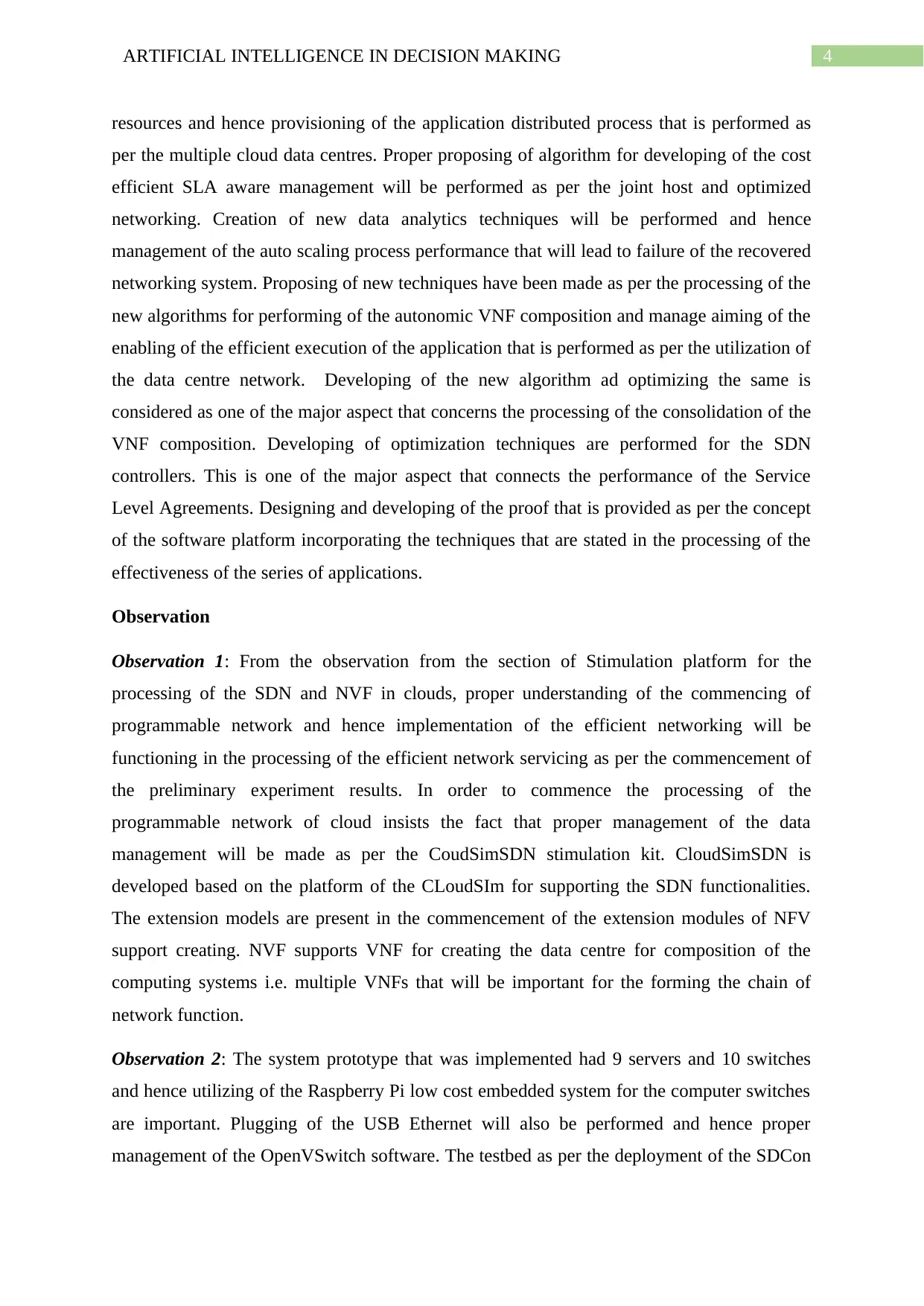
4ARTIFICIAL INTELLIGENCE IN DECISION MAKING
resources and hence provisioning of the application distributed process that is performed as
per the multiple cloud data centres. Proper proposing of algorithm for developing of the cost
efficient SLA aware management will be performed as per the joint host and optimized
networking. Creation of new data analytics techniques will be performed and hence
management of the auto scaling process performance that will lead to failure of the recovered
networking system. Proposing of new techniques have been made as per the processing of the
new algorithms for performing of the autonomic VNF composition and manage aiming of the
enabling of the efficient execution of the application that is performed as per the utilization of
the data centre network. Developing of the new algorithm ad optimizing the same is
considered as one of the major aspect that concerns the processing of the consolidation of the
VNF composition. Developing of optimization techniques are performed for the SDN
controllers. This is one of the major aspect that connects the performance of the Service
Level Agreements. Designing and developing of the proof that is provided as per the concept
of the software platform incorporating the techniques that are stated in the processing of the
effectiveness of the series of applications.
Observation
Observation 1: From the observation from the section of Stimulation platform for the
processing of the SDN and NVF in clouds, proper understanding of the commencing of
programmable network and hence implementation of the efficient networking will be
functioning in the processing of the efficient network servicing as per the commencement of
the preliminary experiment results. In order to commence the processing of the
programmable network of cloud insists the fact that proper management of the data
management will be made as per the CoudSimSDN stimulation kit. CloudSimSDN is
developed based on the platform of the CLoudSIm for supporting the SDN functionalities.
The extension models are present in the commencement of the extension modules of NFV
support creating. NVF supports VNF for creating the data centre for composition of the
computing systems i.e. multiple VNFs that will be important for the forming the chain of
network function.
Observation 2: The system prototype that was implemented had 9 servers and 10 switches
and hence utilizing of the Raspberry Pi low cost embedded system for the computer switches
are important. Plugging of the USB Ethernet will also be performed and hence proper
management of the OpenVSwitch software. The testbed as per the deployment of the SDCon
resources and hence provisioning of the application distributed process that is performed as
per the multiple cloud data centres. Proper proposing of algorithm for developing of the cost
efficient SLA aware management will be performed as per the joint host and optimized
networking. Creation of new data analytics techniques will be performed and hence
management of the auto scaling process performance that will lead to failure of the recovered
networking system. Proposing of new techniques have been made as per the processing of the
new algorithms for performing of the autonomic VNF composition and manage aiming of the
enabling of the efficient execution of the application that is performed as per the utilization of
the data centre network. Developing of the new algorithm ad optimizing the same is
considered as one of the major aspect that concerns the processing of the consolidation of the
VNF composition. Developing of optimization techniques are performed for the SDN
controllers. This is one of the major aspect that connects the performance of the Service
Level Agreements. Designing and developing of the proof that is provided as per the concept
of the software platform incorporating the techniques that are stated in the processing of the
effectiveness of the series of applications.
Observation
Observation 1: From the observation from the section of Stimulation platform for the
processing of the SDN and NVF in clouds, proper understanding of the commencing of
programmable network and hence implementation of the efficient networking will be
functioning in the processing of the efficient network servicing as per the commencement of
the preliminary experiment results. In order to commence the processing of the
programmable network of cloud insists the fact that proper management of the data
management will be made as per the CoudSimSDN stimulation kit. CloudSimSDN is
developed based on the platform of the CLoudSIm for supporting the SDN functionalities.
The extension models are present in the commencement of the extension modules of NFV
support creating. NVF supports VNF for creating the data centre for composition of the
computing systems i.e. multiple VNFs that will be important for the forming the chain of
network function.
Observation 2: The system prototype that was implemented had 9 servers and 10 switches
and hence utilizing of the Raspberry Pi low cost embedded system for the computer switches
are important. Plugging of the USB Ethernet will also be performed and hence proper
management of the OpenVSwitch software. The testbed as per the deployment of the SDCon
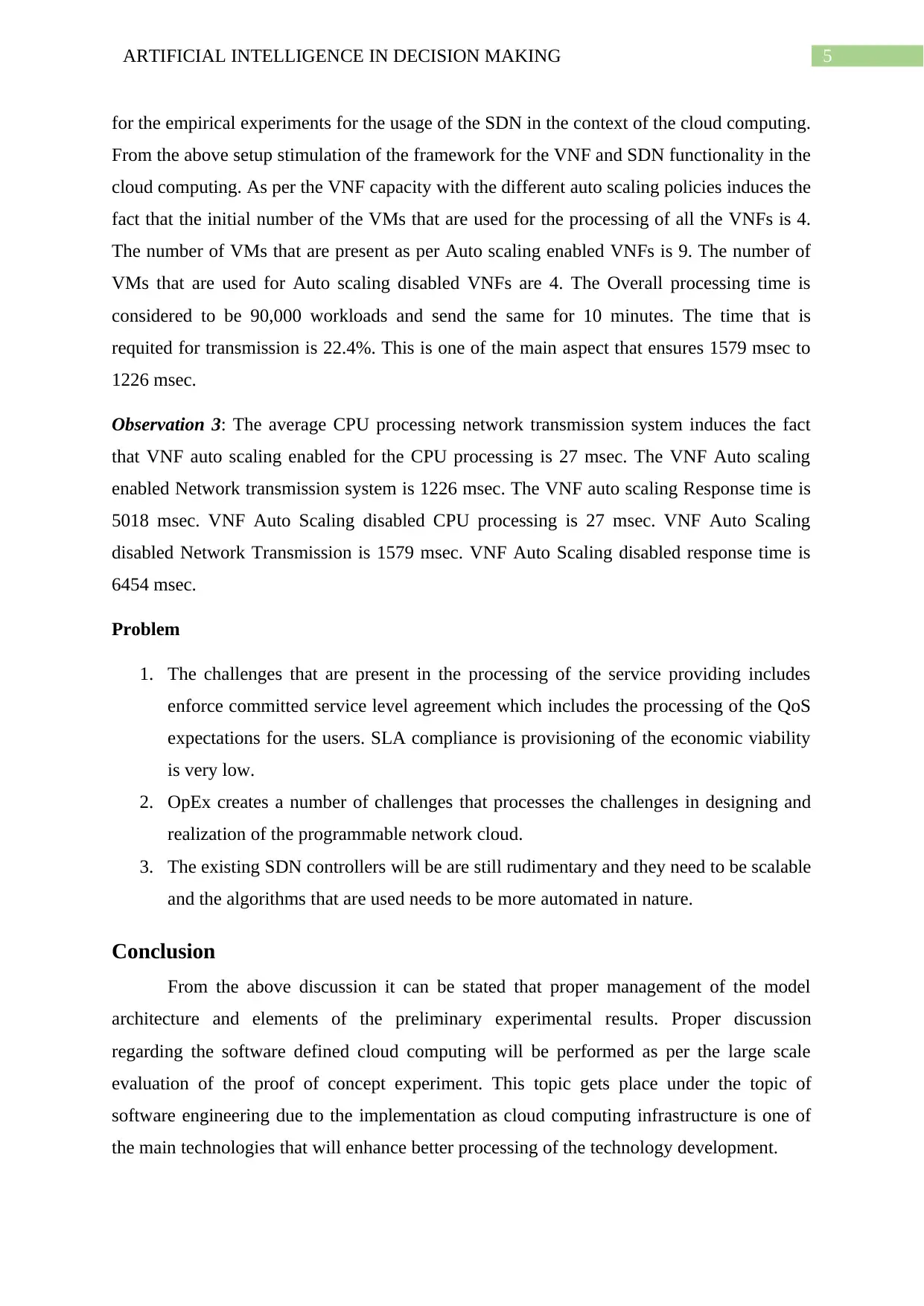
5ARTIFICIAL INTELLIGENCE IN DECISION MAKING
for the empirical experiments for the usage of the SDN in the context of the cloud computing.
From the above setup stimulation of the framework for the VNF and SDN functionality in the
cloud computing. As per the VNF capacity with the different auto scaling policies induces the
fact that the initial number of the VMs that are used for the processing of all the VNFs is 4.
The number of VMs that are present as per Auto scaling enabled VNFs is 9. The number of
VMs that are used for Auto scaling disabled VNFs are 4. The Overall processing time is
considered to be 90,000 workloads and send the same for 10 minutes. The time that is
requited for transmission is 22.4%. This is one of the main aspect that ensures 1579 msec to
1226 msec.
Observation 3: The average CPU processing network transmission system induces the fact
that VNF auto scaling enabled for the CPU processing is 27 msec. The VNF Auto scaling
enabled Network transmission system is 1226 msec. The VNF auto scaling Response time is
5018 msec. VNF Auto Scaling disabled CPU processing is 27 msec. VNF Auto Scaling
disabled Network Transmission is 1579 msec. VNF Auto Scaling disabled response time is
6454 msec.
Problem
1. The challenges that are present in the processing of the service providing includes
enforce committed service level agreement which includes the processing of the QoS
expectations for the users. SLA compliance is provisioning of the economic viability
is very low.
2. OpEx creates a number of challenges that processes the challenges in designing and
realization of the programmable network cloud.
3. The existing SDN controllers will be are still rudimentary and they need to be scalable
and the algorithms that are used needs to be more automated in nature.
Conclusion
From the above discussion it can be stated that proper management of the model
architecture and elements of the preliminary experimental results. Proper discussion
regarding the software defined cloud computing will be performed as per the large scale
evaluation of the proof of concept experiment. This topic gets place under the topic of
software engineering due to the implementation as cloud computing infrastructure is one of
the main technologies that will enhance better processing of the technology development.
for the empirical experiments for the usage of the SDN in the context of the cloud computing.
From the above setup stimulation of the framework for the VNF and SDN functionality in the
cloud computing. As per the VNF capacity with the different auto scaling policies induces the
fact that the initial number of the VMs that are used for the processing of all the VNFs is 4.
The number of VMs that are present as per Auto scaling enabled VNFs is 9. The number of
VMs that are used for Auto scaling disabled VNFs are 4. The Overall processing time is
considered to be 90,000 workloads and send the same for 10 minutes. The time that is
requited for transmission is 22.4%. This is one of the main aspect that ensures 1579 msec to
1226 msec.
Observation 3: The average CPU processing network transmission system induces the fact
that VNF auto scaling enabled for the CPU processing is 27 msec. The VNF Auto scaling
enabled Network transmission system is 1226 msec. The VNF auto scaling Response time is
5018 msec. VNF Auto Scaling disabled CPU processing is 27 msec. VNF Auto Scaling
disabled Network Transmission is 1579 msec. VNF Auto Scaling disabled response time is
6454 msec.
Problem
1. The challenges that are present in the processing of the service providing includes
enforce committed service level agreement which includes the processing of the QoS
expectations for the users. SLA compliance is provisioning of the economic viability
is very low.
2. OpEx creates a number of challenges that processes the challenges in designing and
realization of the programmable network cloud.
3. The existing SDN controllers will be are still rudimentary and they need to be scalable
and the algorithms that are used needs to be more automated in nature.
Conclusion
From the above discussion it can be stated that proper management of the model
architecture and elements of the preliminary experimental results. Proper discussion
regarding the software defined cloud computing will be performed as per the large scale
evaluation of the proof of concept experiment. This topic gets place under the topic of
software engineering due to the implementation as cloud computing infrastructure is one of
the main technologies that will enhance better processing of the technology development.

6ARTIFICIAL INTELLIGENCE IN DECISION MAKING
Paraphrase This Document
Need a fresh take? Get an instant paraphrase of this document with our AI Paraphraser

7ARTIFICIAL INTELLIGENCE IN DECISION MAKING
Bibliography
[1] R. Buyya, and J.Son. Software-defined multi-cloud computing: a vision, architectural
elements, and future directions. In International Conference on Computational Science and
Its Applications (pp. 3-18). Springer, Cham, 2018
Bibliography
[1] R. Buyya, and J.Son. Software-defined multi-cloud computing: a vision, architectural
elements, and future directions. In International Conference on Computational Science and
Its Applications (pp. 3-18). Springer, Cham, 2018
1 out of 8
Related Documents
Your All-in-One AI-Powered Toolkit for Academic Success.
+13062052269
info@desklib.com
Available 24*7 on WhatsApp / Email
![[object Object]](/_next/static/media/star-bottom.7253800d.svg)
Unlock your academic potential
© 2024 | Zucol Services PVT LTD | All rights reserved.





